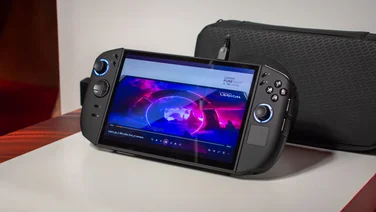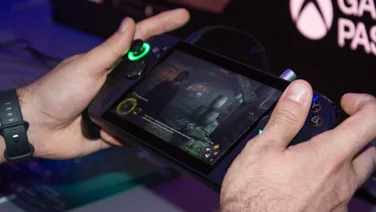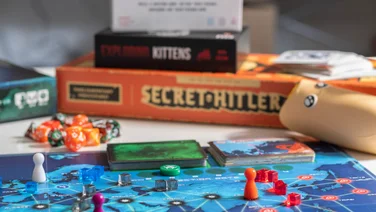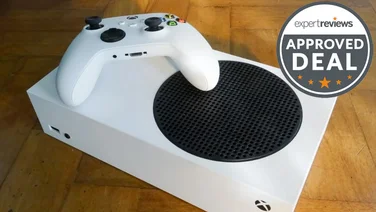To help us provide you with free impartial advice, we may earn a commission if you buy through links on our site. Learn more
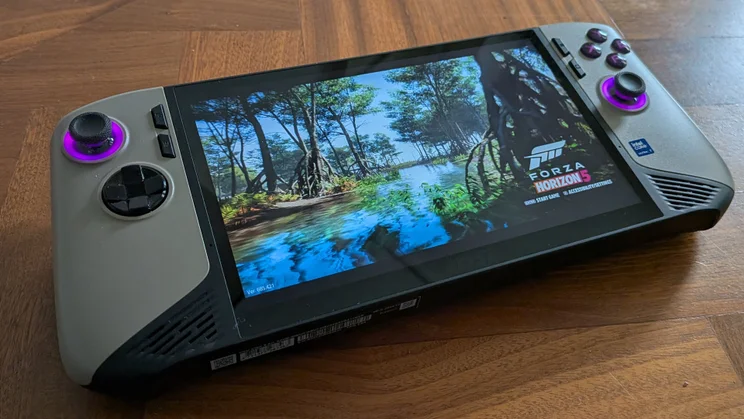
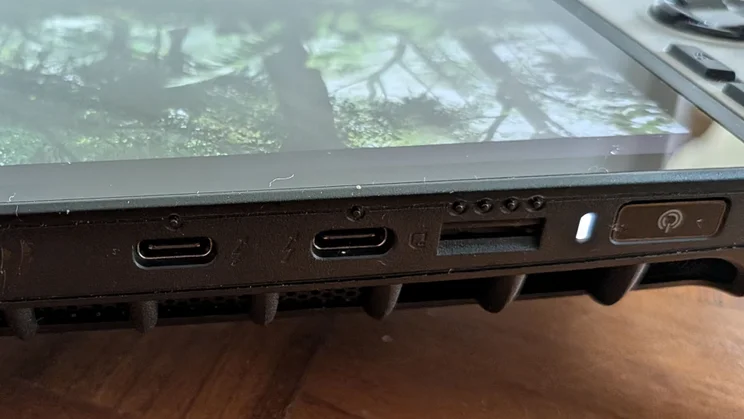
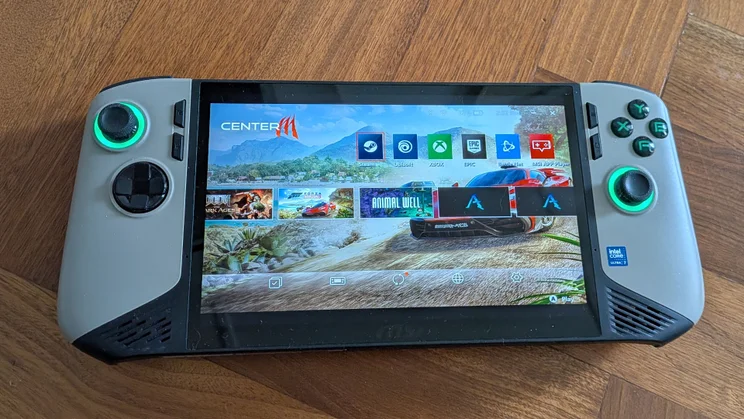
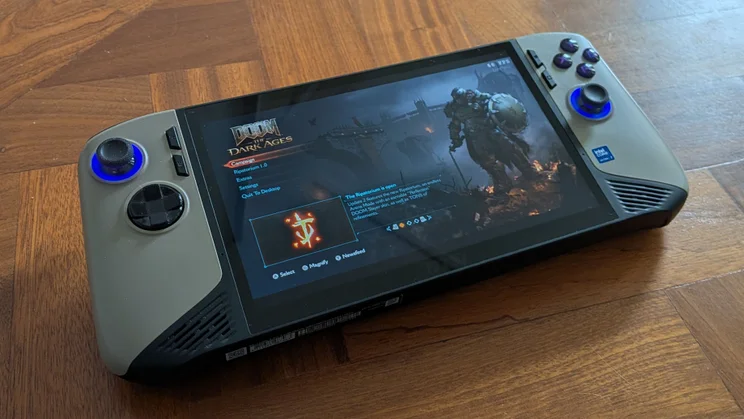
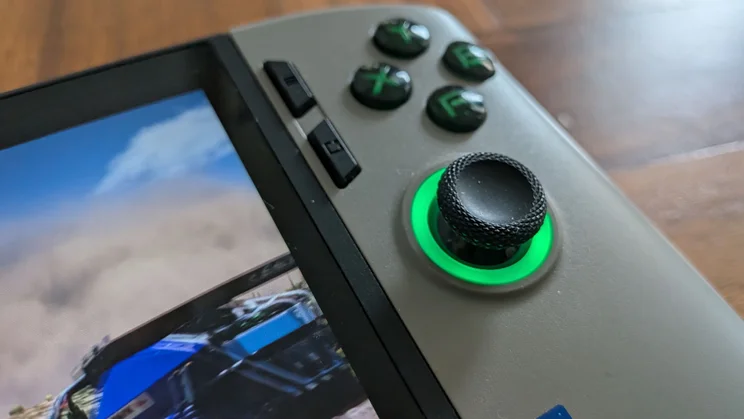
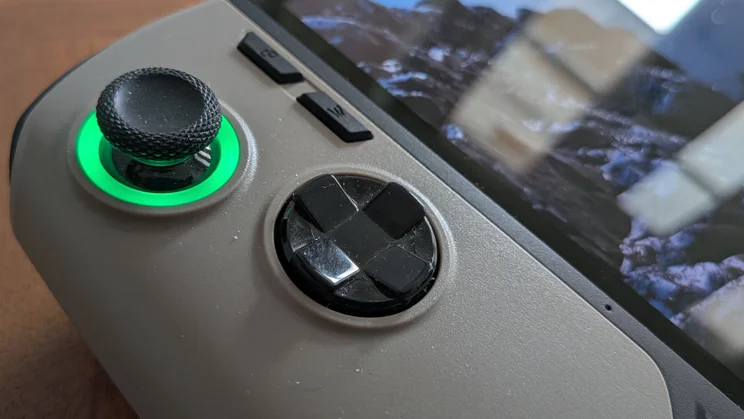
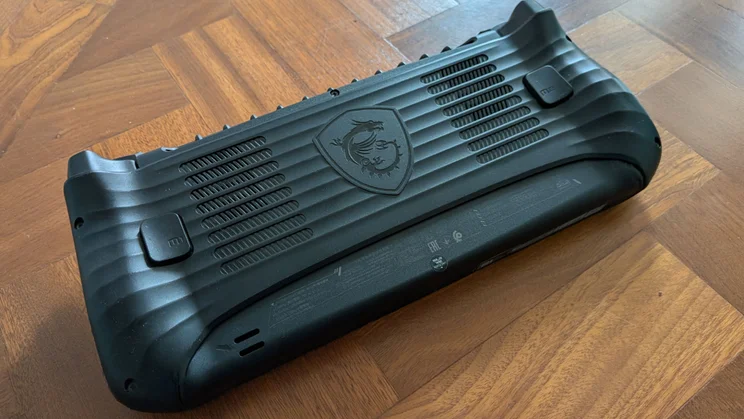
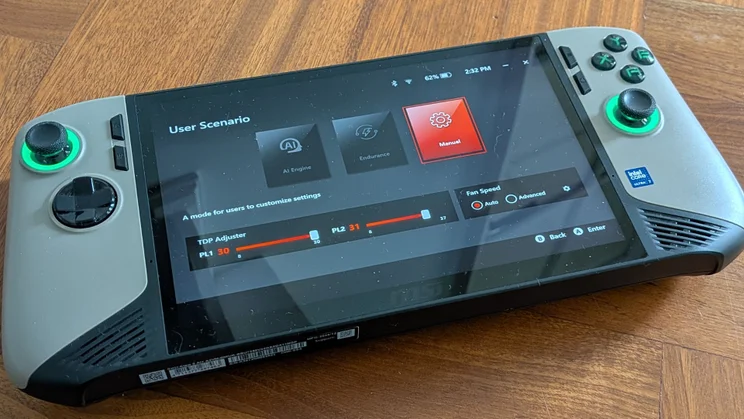
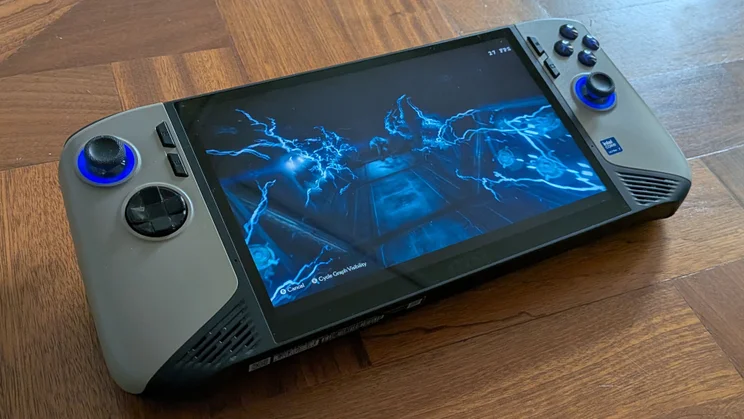
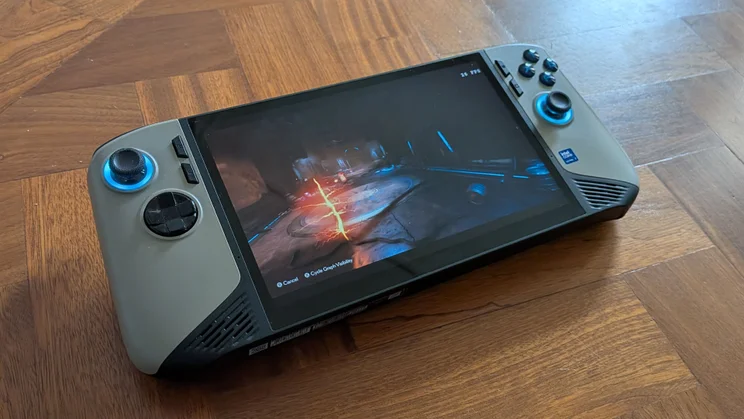
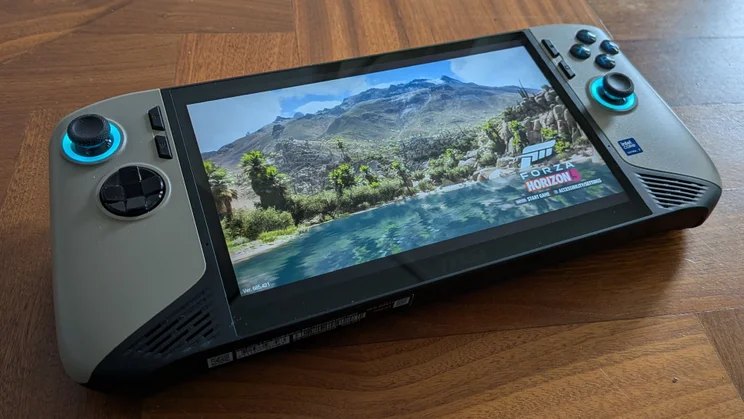
- Can handle titles that cheaper handhelds can’t
- Vibrant and immersive 8in screen
- Good ergonomics and controls
- Windows UI still poses problems
- Limited stamina when running at full tilt
- Big and expensive
The MSI Claw 8 AI+ A2VM is a handheld gaming PC determined to stretch your definition of ‘handheld’. Barring the original Lenovo Legion Go, the Acer Nitro Blaze 8 and Nitro Blaze 11, the latter two of which aren’t set to be released in the UK, it’s comfortably the biggest handheld out there. Its 795g weight crushes the 678g ROG Ally X and even the 740g Legion Go S. With its 8in screen, thick back and chunky grips, it’s almost monumental.
Yet you can see the trade-off that MSI is aiming for here. Are you willing to live with this massive beast to get a better handheld gaming experience, one that gets you closer to current console graphics in a device you can still use on the train or plane? To make that work, it needs to deliver something more than the competition, without affecting comfort, and I’ve been using the Claw 8 AI+ over the last three weeks to find out if it pulls it off.
What you need to know
This is MSI’s follow-up to the Claw 7 A1M, the first mainstream Intel-powered gaming handheld, based on Intel’s Meteor Lake CPU tech. The Claw 7 A1M suffered from what you might call a rough launch. The hardware was fine, but Intel’s drivers weren’t where they needed to be, and MSI’s own software was a mess. Games ran poorly, if at all, though this improved with some judicious tweaks and patches.
The Claw 8 AI+ is a different proposition. It’s based on Intel’s newer Lunar Lake Core Ultra 7 CPU AND uses Intel’s new and improved Arc Battlemage graphics tech, putting performance in a higher league. Doubling the RAM to 32GB also has an impact on demanding titles, while a 1TB SSD is now standard. What’s more, you get an 8in screen rather than a 7in display, with a 16:10 aspect ratio and a 1,920 x 1,200 resolution.











Crucially, Intel and MSI have had more time to fix the software issues, making this a much more reliable gaming option. I’ve tried a wide range of games on the Claw and (so far) have run everything I’ve tried.
Price and competition
This is unapologetically a high-end handheld, with a £899 price point to let you know that it’s aimed at a serious gaming audience, rising to £999 for the white 2TB variant. That’s over £400 more expensive than the entry-level OLED Steam Deck and £100 more expensive than the current performance leader, the Asus ROG Ally X.
Compare it to the premium Lenovo Legion Go S with the AMD Ryzen Z1 Extreme CPU, and there’s a £200 price premium. The only way you can spend more on a handheld console is to splash out on the upcoming Legion Go 2, where the flagship Z2 Extreme/32GB model costs a panic-inducing £1,099.
The Claw 8 AI+ outspecs the Asus ROG Ally X with a newer CPU and GPU architecture, as well as 32GB of RAM rather than 24GB, and offers a larger screen to boot. And while the forthcoming ROG Xbox Ally X will feature a faster Ryzen AI Z2 Extreme processor, it won’t match the MSI in terms of RAM. The high-end Legion Go S matches the Claw 8 AI+’s RAM and screen size, but uses the older Z1 Extreme CPU. We haven’t yet run benchmarks on either the Asus or Lenovo handhelds, but there’s certainly potential for MSI to grab an early performance lead.
Design and connectivity
The Claw 8 AI+ sticks to the layout established by previous non-Valve handhelds, including the Claw 7 A1M, ROG Ally and Legion Go S. The 299 mm wide face is dominated by the 8in screen, the glass of which fills the space from almost top to bottom, with under 2mm of matt black bezel above and below.
To the side, you have two ‘Sandstorm’ coloured panels housing the analogue pads and buttons, with the ridged black plastic rear moulded to give you two large and comfortable grips. If you’re used to the Steam Deck, you may find the space in between surprisingly thick. To allow for laptop-grade components and a lot of ventilation, the Claw 8 AI+ is 18mm to 19mm thick behind the screen.











It’s a monster, but it’s not uncomfortable. In fact, it’s surprisingly easy to hold and game with over quite extended periods, which isn’t something I could even say about my old Nintendo Switch. The weight might be an issue if, like me, you’re not a regular at the gym, but you can get around this by resting it on a knee, or on your chest or belly if you’re sofa-bound. In fact, if you have a little extra cushioning here, you’ll find it even easier to manage.
All connectivity is at the top, with two Thunderbolt 4/USB Type-C ports for charging and connection to storage, displays or a dock, a 3.5mm audio output, plus a Micro SD 4.0 slot. You’re not going to get SSD-class transfer speeds from this, and it’s slower than the Switch 2’s MicroSD Express, but the Steam Deck has proved that slower storage doesn’t mean you can’t use MicroSD to host AAA games. The USB-C ports also support USB-PD charging, with a 65W charger included.
Controls
The Claw 8 AI+ uses Hall Effect analogue sticks and triggers, giving you higher levels of accuracy and less chance of encountering the dreaded stick drift, which is pretty crucial in a handheld where you’ll be using the built-in controls for several years.
The layout apes the asymmetrical Xbox standard rather than the symmetrical Steam Deck or PlayStation styles, which goes with the four A, B, X, Y face buttons, D-Pad and left and right trigger/bumper arrangement. There’s also a large, customisable rear bumper clinging close to the side of each grip. The most confusing controls are the four function buttons, two on each side, with the top two covering the usual pause and options functions, and the bottom two taking you to the MSI CenterM app and a handy quick settings panel.











The power and volume controls are on the top edge of the device, with the power button doubling as a fingerprint scanner. This works consistently every time you wake from sleep, though you’ll still have to type in a passcode when you power on from cold.
Overall, MSI has got the controls right. The sticks are sensitive with no massive central dead spots, and the concave shape and chunky surrounds keep your thumbs firmly locked in position. The face buttons are slightly clicky and have a quick, positive response. If you’re used to an Xbox controller, you’ll find the bumpers and triggers fall naturally beneath the fingers, provided you don’t have especially small hands. Switching back and forth between a Steam Deck and the Claw 8 AI+, I found the latter felt more natural and comfortable in my hands, particularly while playing fast action games.











Being picky, I’d say that there’s quite a lot of travel in the triggers, but also some solid analogue control for racing games where this matters. It didn’t hold me back when slaughtering demons by the dozen in the more manic parts of Doom: The Dark Ages.
It’s a truth universally acknowledged that serious gamers love RGB lighting, and while I’m not personally a fan, the Claw 8 AI+ won’t let RGB fans down. The analogue sticks are surrounded by customisable RGB rings, and the same pulsing and colour cycle options apply to the face buttons as well. MSI has even created an Info Mode, where you can tell what control mode the Claw 8 AI is in by the current RGB glow.
Control modes and software
There are two control modes: a Gamepad mode for general gaming duties and a Desktop mode for navigating Windows or playing games that don’t support a gamepad. In Desktop mode, the left stick handles pointer control, with the A and B buttons left and right-clicking, while the right stick operates as a scroll wheel.
It’s just about usable for changing settings or launching apps if you’re in a fix, but it feels awkward, just like it does on every other handheld where you’re confronted with a Windows UI. In practice, I found it easier just to use the touchscreen. The screen here is big enough that it’s not too fiddly, and it’s a more intuitive way to get things done.
I’d still recommend a Bluetooth mouse for any long or tricky processes, especially when installing apps or troubleshooting, but you can manage with the touchscreen and Desktop mode combo the majority of the time.











While Microsoft is in the process of improving how Windows works on gaming handhelds, for now, Claw owners are still dependent on MSI’s CenterM app. It covers all the Claw’s specific settings, including performance settings and fan speeds (here under User Scenarios), the lighting, system info and noise cancellation features, all of which are pretty easy to get at. You can also take screenshots using the Quick Settings panel, then view them in CenterM’s Gallery.
More importantly, CentreM works as a hub bringing games together from across your services, including Xbox, Steam, Epic Games Store and Ubisoft Connect. I found you needed to run a manual scan after installing new titles to reliably get them added to the lineup, but once they’re there, you can just play by scrolling through horizontally and clicking on the super-sized thumbnail.
It’s not perfect. You still need to install and manage games from within the different launchers, some of which aren’t really designed to be navigated with gamepad controls. There’s also no facility to switch quickly from one game to another and back; you can run more than one title, but the first will simply keep running in the background. Still, while quick-resume features are something console owners have grown used to, they’re hardly par for the course on a PC, which is what the Claw is.











The most vital tool here is the User Scenario controls, which are quickly accessible from CenterM or the Quick Settings panel. You can set different figures for PL1 (the standard power limit) and PL2 (the short-term boost) independently, with the system defaulting to running PL1 at least 1W lower than PL2. You can also use an AI-powered automatic setting, which sets the levels according to the needs of the current app or game, or switch to an Endurance mode aimed at maximising battery life.
Overall, the Claw 8 AI still doesn’t deliver as slick and console-like an experience as the humble Steam Deck, but we’re now at the point where the UI works OK most of the time with only the odd moment when it doesn’t. When it doesn’t, it is a pain, and I did have the odd game not shutting down successfully and some points at which the onscreen keyboard didn’t appear when needed, and needed to be manually invoked. At two points, it didn’t wake from sleep with my game up and running, giving me the blank screen treatment until I held the power button for a restart. At other points, it would wake itself up seconds after being told to sleep. Basically, it’s smooth sailing 95% of the time, but you have to expect a little jank.
Display
There are no such problems with the Claw 8 AI+’s display. It’s an IPS panel with a 1,920 x 1,200 resolution and a 120Hz refresh rate, and it supports VRR to keep things nice and smooth if you’re struggling to maintain a steady frame rate. MSI specifies a brightness level of 500 nits. I measured 499.5cd/m2 with my colorimeter.
Tests also indicate sRGB coverage of 99.4% with a 105.5% gamut and DCI-P3 coverage of 74.5% with a 74.7% gamut. You won’t get the deep blacks and perfect contrast of an OLED screen, but the blacks aren’t hideously grey and contrast is good, at 1414.3:1. Colour accuracy is also solid, with an average Delta-E of only 1.8. I’ll take that on a device that I’m hardly likely to use for professional image-editing or design work.











The crucial thing is that games look great. You don’t get HDR support, but HDR is still patchy on Windows at any rate, while colours are heavily saturated, rich and punchy, which is just what you want for games. What’s more, the additional size and resolution over cheaper handhelds does make for a more immersive, home console-like experience. When playing games on the Steam Deck, you can sometimes be aware that it’s not quite as all-absorbing as playing the same title on a monitor or TV. I barely felt that at all in my time with the Claw.
For the full effect, I’d recommend some headphones. The dual front-facing speakers can put out a decent low-level sound with a modicum of low-end, but there’s a limited stereo spread, and the output sounds congested as you push the volume up.
Performance
The Claw 8 AI+ really lives and dies on its performance, so, luckily, the performance is extremely good. After all, its Core Ultra 7 258V CPU is the same CPU powering some of the best thin-and-light laptops out there, and the Claw 8 AI+’s score of 299 in our 4K Media Benchmarks puts it on par with the HP EliteBook X Flip G1i and ahead of the Dell 14 Plus, both of which use the same chip.
For the sake of comparison, I also ran the older Geekbench 5 benchmark to see how it matched up against the Asus ROG Ally. The ROG Ally scored higher in our 4K Media Benchmarks (347) and in the multi-threaded tests in Geekbench 5, with scores of 1913 (single-threaded) and 10977 (multi-threaded) against 1969 and 9485 from the Claw 8 AI+.
That’s based primarily on CPU performance, where the 8-core, 16-thread Ryzen Z1 Extreme in the ROG Ally has the edge over the 8-core, 8-thread Core Ultra 7. In GPU performance, though, Intel’s hardware pulls ahead. The MSI scores 4402 in the 3D Mark Timespy test and 3285 in the newer Steel Nomad (Light) benchmark. Looking at 3DMark’s published scores for the Z1 Extreme, you’re looking at around 3700 to 3724 for Timespy and 3000 to 3061 for Steel Nomad (Light).











How does this work out in games? Well, the Claw 8 AI+ is pretty comfortable running some games that other handhelds have traditionally struggled with, and can handle other titles at higher resolutions or detail settings, depending on your performance mode. Take Cyberpunk 2077, for example. On the Steam Deck preset on a Steam Deck, I can get it running at 33fps at a 1,280 x 800 resolution, or 46fps with FSR3 upscaling. On the same preset and resolution on the Claw 8 AI+, those figures rise to 40.37fps and 51.89fps (using XESS upscaling) at the same 15W TPD. Switch to the 30W profile, and you’re looking at 67.38fps and 75.48fps.
Up the resolution to 1080p and the settings to Medium, and you still get a playable game, with a 38.1fps frame rate without upscaling and 60fps with XESS on its Balanced setting. This is without frame generation, which you could engage if you felt you needed to and didn’t mind the attendant feeling of lag.
It’s a similar story with Forza Horizon 5, where the Claw 8 AI+ still outperforms the Steam Deck at 15W, getting 56fps to 47fps without upscaling at 1,280 x 800 on the High preset. Shift up to 1080p on High, and the Claw 8 AI+ still hits 45fps, which feels pretty smooth and remains screen-tearing-free. Up the power to 30W, and you can push that up to 53fps.
Even big, tough, cutting-edge triple-A games don’t terrify MSI’s beast. The Steam Deck will just about run Doom: The Dark Ages, but I have to turn the resolution down to 720p and run it on its lowest settings. At 720p/Low, it only scrapes an average of 30fps in the Abyssal Forest benchmark, which upscaling does almost nothing to improve. At 30W, the Claw 8 AI+ hits 41fps or 50.2fps with upscaling, and with upscaling is even just about playable at 1080p on Medium settings. I found 720p Medium was more the sweet spot, though, and happily pushed through a couple of campaign levels, dispatching hellspawn left, right and centre.











And that’s really the story with the Claw8 AI+. I found I could consistently play demanding titles like Doom: The Dark Ages, Cyberpunk 2077, Resident Evil 4 and Avowed on Low to Medium settings at 1080p or even 1280p, and the games looked great and ran smoothly. Sometimes I had to lower the resolution to avoid any jerkiness, but not to the extent that it spoiled the game.
Needless to say, the downside here is battery life. Even with a mighty 80Wh battery, running cutting-edge games at 30W takes its toll. I could only get through around 90 to 110 minutes of gaming before the warnings kicked in and the screen went dark. There is a turbo 37W setting, but this made battery life even worse (and the Claw 8 AI+ much noisier) for no discernible effect on frame rate.
Dialling down to 15W will net you an extra hour or so, though performance suffers and you’ll want to switch down to 720p to keep things smooth on more demanding games. Still, that’s not a problem if you stick to lighter 2D titles, and I was able to play games like Animal Well and Ender Lilies: Quietus of the Knights for an hour, and only knock the battery down by 22 to 24%. Switch to the Endurance profile, and that dropped even further to around 14%.
It’s also worth experimenting with the AI Engine profile. In some games, it aims too low on TDP, resulting in some nasty frame rate jags. But I found I could play Avowed for a good three hours before the usual battery warnings arrived.











When it comes to our standard video playback benchmark, the Claw8 AI+ shows even better stamina. It kept running for 11hrs 49mins of HD video with the screen at 170nits. For comparison, the ROG Ally managed just 4hrs 40mins.
All that power also comes with some noise. At 30W, it puts out a noticeable 37 to 39dBA racket, which drops to around 31dBA at 15W. You can’t hear it over the TV if you’re playing while someone else is in the room, but there’s still a perceptible fan whine on the higher power profiles.
The 1TB of SSD storage gives you room for a decent selection of games, though with some titles hitting 120GB to 200GB these days, you can never cram on everything you’d like. It’s reasonably speedy too, with sequential read speeds of 4,270MB/sec and write speeds of 1,408MB/sec. You’re not facing epic times for games to load.
Verdict
Currently, the Claw 8 AI+ stands out as the ultimate high-performance handheld console. It’s massive, but you get an enormous screen, not to mention the performance needed for games to run at something approaching the screen’s native resolution. The battery life at 30W and upwards still isn’t quite enough for gaming on the go, but it’s brilliant for 90-minute sessions with a charger nearby, or – if you can manage it – just playing while it’s plugged in.
In many ways, it’s the first handheld that I’ve played on where I could imagine it as my only games machine. However, it’s still hugely expensive, and I suspect that many gamers are still looking for a companion device and are happy to run at lower details on a lower-resolution screen for a lower price point. Still, that’s not the Claw 8 AI+’s market; it’s built for those who demand a whole lot more.

